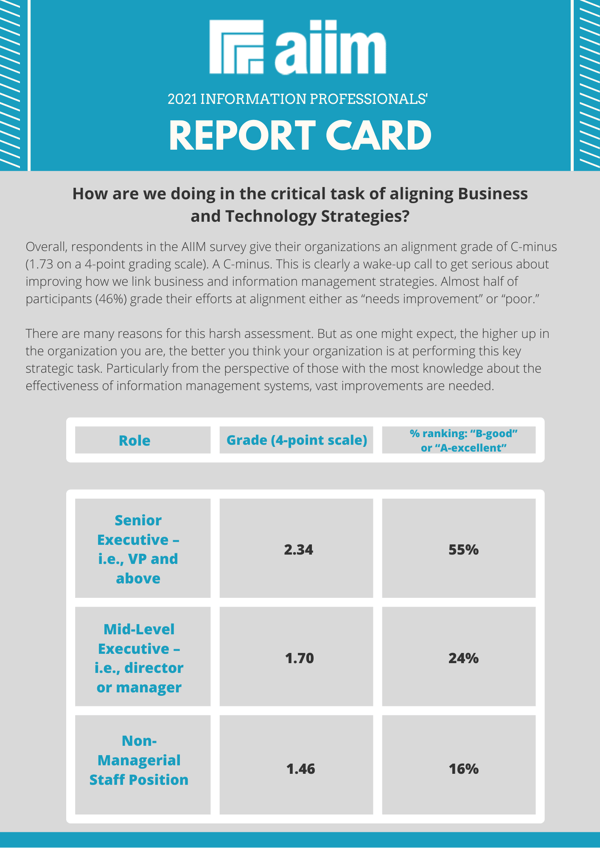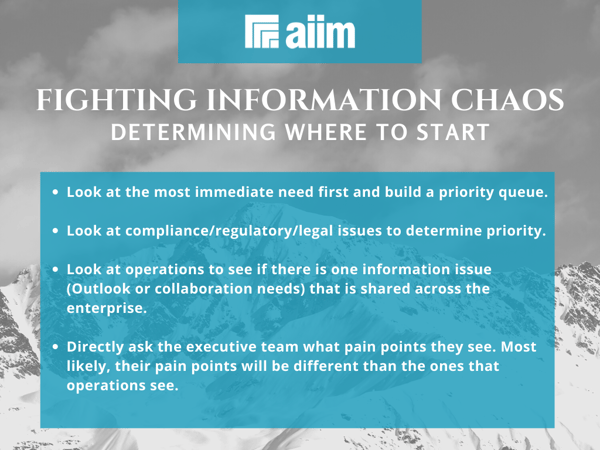
Five Steps to Win the Battle Against Information Chaos in 2021
Intelligent Information Management (IIM)
We surveyed members of the AIIM Community as a part of our yearly look at the state of the industry. The numbers are in— 46% of respondents graded their organizations as poor or needs improvement when it comes to dealing with the rising tide of information chaos. Even more alarming, senior executives feel more confident in their efforts than the reality would suggest.
Here's a look at how the AIIM Community self-assessed on how well the strategies for business and technology align in their organization. For fun and visual effect, we've created this 2021 Informational Professionals' report card to present the results.

How to Deal with Information Chaos
So, what can be done, and where should we begin? According to our CIP Expert Panel, here are four steps you can take to win this battle.
Step 1: Recognize that Change Management Isn't Just for Frontline Workers
You can have some great, fantastic ideas about what you want to do with information, but you need to be able to educate everyone up and down the stack about what you are planning. You need to be able to go to that frontline worker and explain what’s in it for them, but you also need to be able to explain to the C-Suite what’s in it for them - a practice known as Change Management.
As we saw in the Information Professionals' Report Card above, there is a current disconnect between upper management and those on the front lines of information management on how well the current initiatives are working. Be explicit about the C-Suite support you need. Bring enterprise-wide initiatives to senior executives before investing any time in implementation. Give them a countdown of activities that are expected so there are no surprises. State explicitly: “This is what we need from you.” Do not assume they will know what you expect them to do or that they will automatically buy-in.
Step 2: Turn Your Attention to the Lifecycle of Information
Focus on a specific element of the information lifecycle, depending on the nature of your business. Not every organization can wrap its head around the whole lifecycle (from creation and digitization to records management and ultimate disposition). Each has a story, slightly different priorities, and different regulatory drivers to consider. But most businesses have some part of the information lifecycle that they’re good at. Start by putting emphasis on that and expanding that capability.
Step 3: Understand that You Can't Control What You Can't See
In many organizations, the chaos problem isn’t simply about information volume and variety. It can be the “Wild West” with silos of information you don’t even know about. And while sheer volume and variety can be key factors, the most important drivers to change are getting a better view of where ALL the information is, how it’s being managed, the risks associated with that information, and the compensating controls that need to be in place.
Step 4: Pick Where to Start
Then, you must pick a place to start! Is there a major regulatory drive like GDPR, PII, or CCPA in your organization? Is there the possibility of a giant fine for unmanaged information? Is that what gets management’s attention? Or does management worry about more reputational risk, which makes any potential fine for non-compliance pale into insignificance? If you can only do so much, how do you prioritize? The prioritization has to be business-driven and business-led. It might be tempting to do a quick and easy fix, but it’s best to take a different view and say, “This problem might be really difficult, and it will cost more and will take longer to do. But we need to do that one first.”
This graphic outlines how to determine where to start:
Step 5: Engage the Business in Solving the Chaos Challenge
How do we explain the benefits of freeing up IT to work on the “right” things? If the IT department has been stretched to its limit by implementing new VPN hardware or figuring out how to support remote users effectively, how much bandwidth will they have to help teams manage their information effectively? Organizations need to ask themselves how much information management work can be offloaded from IT and handled by the business teams. If the business team is mature enough, can it enhance its own effectiveness by embracing the “citizen developer” movement? Can business users be educated and trained to use no-code development environments to improve their workflows and automate some processes? Work by IT to support the ability of business teams to “learn to fish” can pay large dividends. And for the business team, the short-term pain of focusing on “non-core” work to improve their information management processes will yield long-term benefits.
More on the Battle Against Information Chaos
Information is your business’s most valuable asset, but it’s hard to access its potential if your information management processes are in chaos. Get ahead of it today by following these four steps and be on your way to finding opportunity in all the chaos.
For more on information chaos and the state of Intelligent Information Management industry, check out this analyst briefing video. In it, John Mancini takes a deep look at what the data is telling us are the most important topics in our industry for 2021 and beyond.
Download the Report
Using a web-based tool in February 2021, nearly 300 executives weighed in on the research study. All the participants were drawn from the AIIM Community. This is important because it means the responses are from an informed audience that understands the benefits – and the reality – of information management in their organizations. Get your Free copy of the report.



